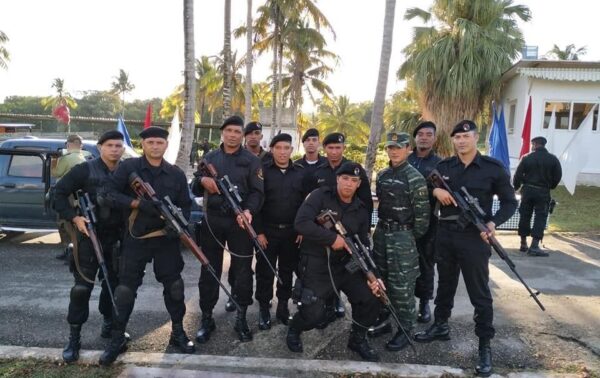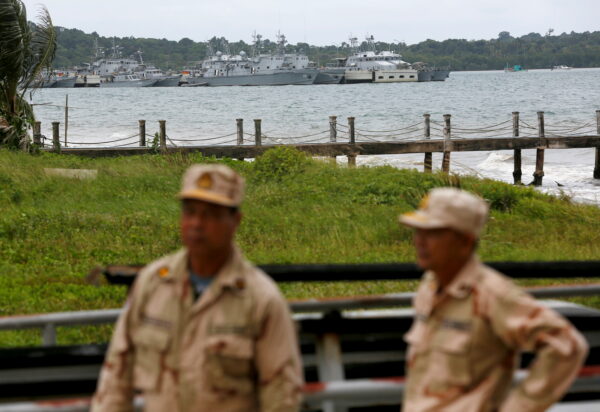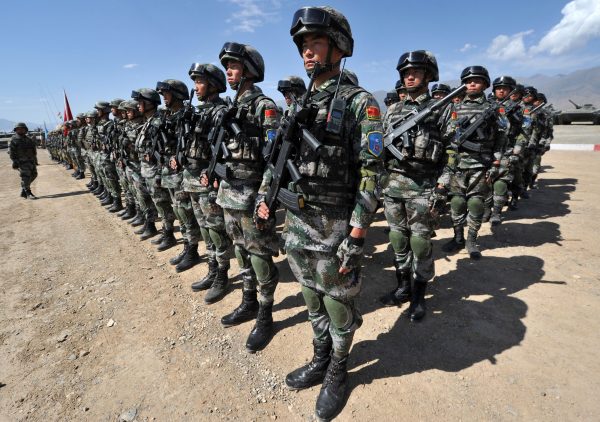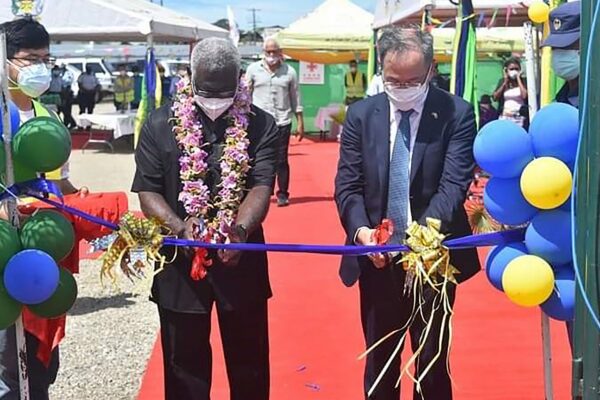Where in the World Is China’s Military?
News AnalysisThe People’s Liberation Army (PLA) is developing infrastructure and access all around the world. The Chinese Communist Party (CCP) created a unique process to get countries to agree to give the PLA access to key ports and bases via several methods, including the Belt and Road Initiative (BRI). For example, this process can be seen in the first official overseas base—the Doraleh Naval Base in Djibouti, which opened in August 2017. What else has the PLA been up to? This article gathers and highlights some details on PLA overseas locations. The article will discuss three kinds of PLA forward deployments: “permanent,” “as needed,” and “in development.” Note: The PLA’s Strategic Support Force (SSF) is responsible for the telemetry, tracking, and control (TT&C) system for all Chinese satellites with overseas ground stations located in the following: Argentina, Australia, Brazil, Canada, Chile, Ethiopia, France, Greenland, Kenya, Kiribati, Namibia, Norway, Pakistan, South Africa, Spain, Sweden, and four sites in Antarctica. Some of these sites are discussed below. For more details on Chinese Space and the SSF, see #1, #2, and #3. Permanent Bases by Region Latin America Argentina: The PLA operates a “satellite tracking station” in Argentina’s Patagonia region near Neuquén. The site is a de facto PLA military base under the operational control of the PLA’s SSF. The SSF is responsible for centralizing “the PLA’s strategic space, cyber, electronic, information, communications, and psychological warfare missions and capabilities,” including cyber warfare and signals intelligence. In other words, the PLA site may also be used to intercept communications of other countries, companies, and individuals. A recent U.S. government alert asserts the PLA’s capability to conduct cyber operations, which “is a major threat to U.S. and Allied cyberspace assets. Chinese state-sponsored cyber actors aggressively target U.S. and allied political, economic, military, educational, and critical infrastructure, personnel, and organizations to steal sensitive data, critical and emerging key technologies, intellectual property, and personally identifiable information.” The PLA can conduct cyberattacks when directed. Venezuela: The PLA has another “satellite tracking facility” at the Capitán Manuel Rios Air Base in Guárico state, ostensibly to track Chinese-made satellites purchased by Venezuela. This facility could also have capabilities and missions like those at the PLA site in Argentina. According to a 2022 American Foreign Policy Council report, the PLA’s 76th Group Army “has been training jointly with Venezuelan Special Forces on language, diving, sniping, and helicopter landing operations.” Cuba: The PLA is embedded in three signals intelligence collection sites at Lourdes, Bejucal, and Santiago de Cuba. Bejucal also is reported to be a satellite intercept facility. Cuban special forces, called the Black Berets, pose alongside their Chinese trainers from paramilitary in a government-run training school in Cuba in an undated photo. (Courtesy of ADN Cuba) Africa The PLA’s support, especially in manpower, to United Nations peacekeeping missions is the largest of any country in the world and second in terms of total funding (15 percent). The PLA’s support for peacekeeping missions includes deployments to South Sudan, Lebanon, Mali, Sudan, the Democratic Republic of the Congo, the Central African Republic, Lebanon, and Cyprus. According to the 2021 U.S. Department of Defense (DOD) report “Military and Security Developments Involving the People’s Republic of China” (MSD-PRC), “in 2020, the PRC [People’s Republic of China] pledged to take a bigger peacekeeping role in the Sahel and West Africa.” One consequence of China’s growing participation in U.N. peacekeeping missions is that each PLA deployment provides insight and access to places the CCP did not have before the deployment. Namibia: The PLA operates the China TT&C station in Swakopmund, Namibia (Southwest Africa), which opened in 2001. The CCP claims that this station supports manned space flight in conjunction with stations in Karachi, Pakistan, and Malindi in Kenya. According to a Global Security report, “China’s Xi’an Satellite Control Center in Shaanxi operates the Swakopmund ground station. … The station houses 20 permanent staff during a mission phase, while about five personnel stay there continuously to maintain the equipment.” According to the DOD MSD-PRC report, “the SSF operates tracking, telemetry, and command stations in Namibia, Pakistan, and Argentina. The SSF also operates Yuan Wang space support ships that track the satellite and intercontinental ballistic missile (ICBM) launches.” Thus, the Namibia site houses PLA personnel that support manned space flight, satellite tracking, and intercontinental ballistic missile (ICBM) launches. Kenya: The PLA operates a manned space flight support at the TT&C station in Malindi, Kenya. This fac

News Analysis
The People’s Liberation Army (PLA) is developing infrastructure and access all around the world. The Chinese Communist Party (CCP) created a unique process to get countries to agree to give the PLA access to key ports and bases via several methods, including the Belt and Road Initiative (BRI).
For example, this process can be seen in the first official overseas base—the Doraleh Naval Base in Djibouti, which opened in August 2017.
What else has the PLA been up to? This article gathers and highlights some details on PLA overseas locations.
The article will discuss three kinds of PLA forward deployments: “permanent,” “as needed,” and “in development.”
Note: The PLA’s Strategic Support Force (SSF) is responsible for the telemetry, tracking, and control (TT&C) system for all Chinese satellites with overseas ground stations located in the following: Argentina, Australia, Brazil, Canada, Chile, Ethiopia, France, Greenland, Kenya, Kiribati, Namibia, Norway, Pakistan, South Africa, Spain, Sweden, and four sites in Antarctica. Some of these sites are discussed below. For more details on Chinese Space and the SSF, see #1, #2, and #3.
Permanent Bases by Region
Latin America
Argentina: The PLA operates a “satellite tracking station” in Argentina’s Patagonia region near Neuquén. The site is a de facto PLA military base under the operational control of the PLA’s SSF.
The SSF is responsible for centralizing “the PLA’s strategic space, cyber, electronic, information, communications, and psychological warfare missions and capabilities,” including cyber warfare and signals intelligence. In other words, the PLA site may also be used to intercept communications of other countries, companies, and individuals.
A recent U.S. government alert asserts the PLA’s capability to conduct cyber operations, which “is a major threat to U.S. and Allied cyberspace assets. Chinese state-sponsored cyber actors aggressively target U.S. and allied political, economic, military, educational, and critical infrastructure, personnel, and organizations to steal sensitive data, critical and emerging key technologies, intellectual property, and personally identifiable information.” The PLA can conduct cyberattacks when directed.
Venezuela: The PLA has another “satellite tracking facility” at the Capitán Manuel Rios Air Base in Guárico state, ostensibly to track Chinese-made satellites purchased by Venezuela. This facility could also have capabilities and missions like those at the PLA site in Argentina.
According to a 2022 American Foreign Policy Council report, the PLA’s 76th Group Army “has been training jointly with Venezuelan Special Forces on language, diving, sniping, and helicopter landing operations.”
Cuba: The PLA is embedded in three signals intelligence collection sites at Lourdes, Bejucal, and Santiago de Cuba. Bejucal also is reported to be a satellite intercept facility.

Africa
The PLA’s support, especially in manpower, to United Nations peacekeeping missions is the largest of any country in the world and second in terms of total funding (15 percent). The PLA’s support for peacekeeping missions includes deployments to South Sudan, Lebanon, Mali, Sudan, the Democratic Republic of the Congo, the Central African Republic, Lebanon, and Cyprus.
According to the 2021 U.S. Department of Defense (DOD) report “Military and Security Developments Involving the People’s Republic of China” (MSD-PRC), “in 2020, the PRC [People’s Republic of China] pledged to take a bigger peacekeeping role in the Sahel and West Africa.”
One consequence of China’s growing participation in U.N. peacekeeping missions is that each PLA deployment provides insight and access to places the CCP did not have before the deployment.
Namibia: The PLA operates the China TT&C station in Swakopmund, Namibia (Southwest Africa), which opened in 2001. The CCP claims that this station supports manned space flight in conjunction with stations in Karachi, Pakistan, and Malindi in Kenya.
According to a Global Security report, “China’s Xi’an Satellite Control Center in Shaanxi operates the Swakopmund ground station. … The station houses 20 permanent staff during a mission phase, while about five personnel stay there continuously to maintain the equipment.”
According to the DOD MSD-PRC report, “the SSF operates tracking, telemetry, and command stations in Namibia, Pakistan, and Argentina. The SSF also operates Yuan Wang space support ships that track the satellite and intercontinental ballistic missile (ICBM) launches.”
Thus, the Namibia site houses PLA personnel that support manned space flight, satellite tracking, and intercontinental ballistic missile (ICBM) launches.
Kenya: The PLA operates a manned space flight support at the TT&C station in Malindi, Kenya. This facility performs similar functions to sites in Pakistan and Namibia.
Equatorial Guinea (EG): Rumors abound regarding the possible agreement between the EG government and the CCP for providing the PLA with access to the Bata port (former EG capital, largest EG city, and one of the deepest seaports—16-18 meters deep—in the region). The BRI project greatly expanded the utility of the port and made Bata port an ideal location for PLA Navy (PLAN) use.
Asia
Cambodia: Building on the initial disclosure in The Wall Street Journal in 2019, The Washington Post reported last month that the PLA is “secretly building a naval facility in Cambodia for the exclusive use of its military” on the northern part of the Ream Naval Base. Potential PLA naval and air facilities along the coast have also been identified.

Burma (Myanmar): PLA operates intelligence collection (signal and maritime) facilities on Sittwe and the Great and Small Coco Islands, located at crucial points along the sea lanes between the Bay of Bengal and the Strait of Malacca.
Laos: The PLA has a SIGINT site near Sop Hau that covers the “Strait area from the South China Sea to the Indian Ocean.”
Pakistan: A Chinese TT&C site for manned space flight is located near Karachi, Pakistan. The SSF operates the Karachi site.
Tajikistan: In Tajikistan, the PLA bases are manned full-time by the People’s Armed Police.
- Shaymak base: In October 2021, the Tajik Parliament approved the PLA to start building a military base “in the Gorno-Badakhshan Autonomous Province near the intersection of the Af-China-Tajik borders arena,” near the Wakhan Corridor. More details are found here.
- Another PLA base is under construction or was recently completed near the Tajikistan border with Afghanistan.
As Needed
Solomon Islands
The leaked agreement between China and the Solomon Islands reveals that the CCP is exploring different ways to enable access for their military. The current agreement allows the PLA to access ports in the Solomons. This agreement may be the beginning of a process to eventually allow PLA basing.
Pakistan
The Skardu Air Base is located in Pakistan-occupied Kashmir (POK) on land disputed with India. Other possible PLAAF deployment locations include Gilgit, Chilas, Muzaffarabad in POK, and Chitral and Mansehra in Pakistan, although they are less developed than Skardu. More details on Skardu and Gilgit can be found here.
China’s 2019 defense white paper tasks the PLA with protecting Chinese cargo ships and developing “overseas logistical facilities.” Currently, the PLAN relies on facilities at overseas ports owned or operated by Chinese state enterprises.
According to an April MIT research report, “Chinese firms own or operate terminal assets in ninety-six ports in fifty-three countries,” including the assets listed below:
- Gwadar, Pakistan: Deepwater port allows for large PLAN ships and submarines, much like Djibouti. Satellite photographs show a PLA high-security compound being built in 2017 and completed by 2020.
- Chabahar, Iran: First Iranian deepwater port not located in the Persian Gulf.
- Jask and Kish Ports, Iran: Possible intelligence collection site and access control site for Arabian Gulf shipping.
- Hambantota Port and Colombo Port, Sri Lanka: Recent flight of Rajapaksa leadership raises uncertainty regarding domestic support, but the economic crisis may facilitate it. More details here.
Shanghai Cooperation Organization
In addition to individual countries allowing PLA basing, the Shanghai Cooperation Organization (SCO) provides another means to deploy PLA to alliance countries. The SCO is a Eurasian political, economic, and security alliance. This alliance consists of the following members, observers, and dialogue partners:
- Eight member states: India, Kazakhstan, China, Kyrgyz Republic, Pakistan, Russian Federation, Tajikistan, and Uzbekistan.
- Four observer states: Afghanistan, Belarus, Iran, and Mongolia.
- Six dialogue partners: Azerbaijan, Armenia, Cambodia, Nepal, Turkey, and Sri Lanka.
The PLA has used the SCO to deploy the PLA to member states by providing security assistance and counter-terrorist, counter-separatist, and counter-extremist exercises. The SCO is an example of a multilateral alliance that allows for the deployment of military forces in support of member countries.

In Development
According to the current DOD MSD-PRC report, the PLA could be pursuing the following countries for additional “military facilities to support naval, air, ground, cyber, and space power projection”:
- Asia/Indo-Pacific: Cambodia, Indonesia, Kiribati, Burma, Pakistan, Singapore, Thailand, Sri Lanka, and Tajikistan.
- Africa: Angola, Kenya, and Seychelles.
- Middle East: The United States informed the United Arab Emirates that the PLA was building a military compound in the BRI-funded section of the Khalifa Port in Abu Dhabi. The UAE ordered the construction to stop.
South China Sea Bases in Development
The PLA has active bases in the South China Sea (SCS) and is building new ones. Asia Maritime Transparency Initiative (AMTI) summarizes the PLA’s growth in the SCS: “China has 20 outposts in the Paracel Islands and 7 in the Spratlys. It also controls Scarborough Shoal, which it seized in 2012 via a constant coast guard presence, though it has not built any facilities on the feature. Since 2013, China has engaged in unprecedented dredging and artificial island-building in the Spratlys, creating 3,200 acres of new land, along with a substantial expansion of its presence in the Paracels.”
The AMTI provides a list of PLA islands that have been built-up, or are under construction, and includes a link for additional details (highlighted islands are described briefly below):
Spratly Islands: Cuarteron Reef, Fiery Cross Reef, Gaven Reefs, Hughes Reef, Johnson Reef, Mischief Reef, and Subi Reef.
Paracel Islands: Antelope Reef, Bombay Reef, Drummond Island, Duncan Islands, Lincoln Island, Middle Island, Money Island, North Island, North Reef, Observation Bank, Pattle Island, Quanfu Island, Robert Island, South Island, South Sand, Tree Island, Triton Island, West Sand, Woody Island, and Yagong Island.
PLA’s SCS Strategic Bases
Of particular interest are the islands that have runways and large port facilities for the PLAAF and PLAN, respectively. The PLA has four islands in the SCS with 10,000-foot runways: Woody Island (part of the Paracel Islands), Fiery Cross Reef, Mischief Reef, and Subi Reef (all three are part of the Spratly Islands).
The PLA built a SIGINT site on Rocky Island that became a part of Woody Island that covers the “Spratly Islands area, the Philippines, and the Strait of Malacca,” according to the Federation of American Scientists (FAS).

On May 26, an Australian Air Force P-8 aircraft flew in international airspace over the South China Sea near the Paracel Islands when the PLAAF J-16 (probably from Woody Island) intercepted it. During the intercept, the J-16 conducted dangerous maneuvers, including discharging chaff and flares that were sucked into the P-8’s jet engines, which could have caused it to crash.
As the PLA expands its locations and the CCP directs the PLA to become more “territorial,” opportunities increase for dangerous incidents. There are many examples of aggressive behavior by the PLAN, Coast Guard, and auxiliary ships against other countries’ navy and civilian ships.
Scarborough Shoal: Scarborough Shoal is a triangle-shaped chain of reefs and rocks with a 29-mile perimeter and is 120 nautical miles west of the Philippine island of Luzon (well within the 200 nautical miles Philippine EEZ). It is not part of the Spratly nor the Paracel Islands.
The Shoal has the potential to be an important location for the PLA to control the SCS, in part because placing radars and other sensors there would round out the PLA’s SCS coverage, facilitating situational awareness and weapons targeting. Shaped like Mischief Reef and Subi Reef, Scarborough Shoal could be converted easily into another key PLA-occupied island with a 10,000-foot runway and a deepwater port. The PLA is waiting for the opportunity to transform Scarborough Shoal into a base.
Chinese Embassies
The PLA assigns military attachés to 110 diplomatic missions. These military attachés “serve as military advisors to the ambassador, support Ministry of Foreign Affairs and PLA foreign policy objectives and perform a variety of duties tied to PLA military and security cooperation, including counterpart exchanges with host-nation and third-country personnel. Military attachés also conduct clandestine and overt intelligence collection on their countries or areas of assignment,” according to the DOD report.
Each Chinese embassy is a de facto small military base representing the PLA and facilitating PLA access to each country. While this approach is hardly unique, a recent incident at the Pacific Islands Forum in Fiji suggests that China is unusually bold in its use of attachés.
Note: In a follow-on article, the author will analyze indications of PLA and paramilitary deployments and possible basing to ensure China’s global trade is not only disrupted, but also to potentially threaten trade of other countries.












